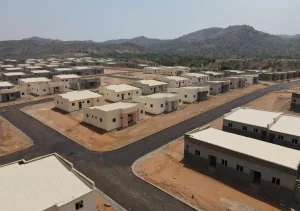
Desktop computers are stationary machines designed for various computing tasks, ranging from basic office work to intensive gaming and multimedia production. Here are the typical features and descriptions of desktop computers:
Features of Desktop Computers:
- Performance:
- Processor (CPU): Powerful CPUs from Intel (Core i5, i7, i9) or AMD (Ryzen series) provide speed and multitasking capabilities.
- Graphics: Options range from integrated graphics for standard tasks to dedicated GPUs (NVIDIA GeForce, AMD Radeon) for gaming and graphic-intensive applications.
- RAM: Configurations typically start at 8GB and can exceed 32GB for handling multiple applications simultaneously.
- Storage:
- Hard Drives (HDD) and Solid State Drives (SSD): Offer varying capacities (from 500GB to several terabytes) for storage of data and applications.
- SSD Benefits: SSDs provide faster boot times, application launch speeds, and data transfer rates compared to traditional HDDs.
- Form Factor:
- Tower: Traditional design with ample internal space for expansion and airflow, suitable for home and office use.
- Compact (Mini or Micro): Smaller footprint ideal for space-saving environments or as media center PCs.
- Connectivity:
- Ports: USB (Type-A and Type-C), HDMI, DisplayPort, Ethernet, audio jacks, and SD card readers for connectivity with peripherals and external devices.
- Wi-Fi: Built-in Wi-Fi connectivity for wireless internet access (optional in some models).
- Expansion Options:
- PCIe Slots: For adding dedicated graphics cards, sound cards, or other expansion cards.
- Drive Bays: Space for additional HDDs, SSDs, or optical drives for customization.
- Operating System:
- Windows: Most commonly pre-installed with Windows 10 or Windows 11 for compatibility and ease of use.
- Mac: Apple desktops run macOS, known for its user-friendly interface and seamless integration with other Apple devices.
- User Interface:
- Monitor Compatibility: Supports various monitor types and resolutions (HD, Full HD, 4K) for crisp visuals and multitasking.
- Keyboard and Mouse: Typically includes wired or wireless peripherals for input and navigation.
Laptop Computers: Features and Description
Laptop computers offer portability and versatility, suitable for professionals, students, and travelers who need computing power on the go. Here are the typical features and descriptions of laptop computers:
Features of Laptop Computers:
- Portability:
- Form Factors: Various sizes including ultraportable (thin and light) models, 2-in-1 convertible laptops (tablet and laptop modes), and standard notebooks.
- Weight: Ranges from under 2 lbs (ultraportables) to 5+ lbs (gaming or workstation laptops).
- Performance:
- Processor: Offers CPUs similar to desktops (Intel Core i5/i7, AMD Ryzen), optimized for power efficiency and performance.
- Graphics: Integrated graphics for standard tasks, with options for discrete GPUs (NVIDIA GTX/RTX, AMD Radeon) in gaming and professional models.
- RAM: Starting from 4GB up to 32GB or more, supporting multitasking and resource-demanding applications.
- Storage:
- SSD: Most laptops use SSDs for faster boot times, application launches, and data transfer speeds.
- HDD Options: Some models offer hybrid configurations (SSD + HDD) for a balance of speed and storage capacity.
- Battery Life:
- Usage Duration: Varies by model and usage, typically ranging from 5 to 12 hours on a single charge.
- Fast Charging: Some laptops support rapid charging technologies for quick battery replenishment.
- Display:
- Screen Sizes: Range from 11 inches (compact) to 17 inches (large screens), with various resolutions (HD, Full HD, 4K) for sharp visuals.
- Touchscreen Options: Available in 2-in-1 convertible laptops for enhanced versatility and productivity.
- Connectivity:
- Ports: USB (Type-A and Type-C), HDMI, Ethernet, headphone jacks, and SD card readers for connecting peripherals and external devices.
- Wireless: Built-in Wi-Fi and Bluetooth connectivity for wireless internet access and device pairing.
- Operating System:
- Windows: Pre-installed with Windows 10 or Windows 11, offering compatibility with a wide range of software and hardware.
- macOS: Apple laptops run macOS, known for its integration with other Apple devices and robust security features.
- Built-in Features:
- Webcam and Microphone: Integrated for video conferencing and virtual meetings.
- Keyboard and Trackpad: Ergonomic designs with backlit keyboards and precision trackpads for comfortable typing and navigation.
Choosing Between Desktop and Laptop:
- Desktops: Ideal for stationary setups, high-performance computing, and customizable configurations.
- Laptops: Suitable for mobility, versatility, and on-the-go productivity, with options ranging from ultraportables to gaming and workstation models.
Both desktop and laptop computers offer distinct advantages based on user needs, whether it’s for office productivity, creative tasks, gaming, or multimedia consumption.






